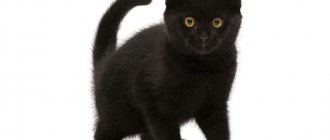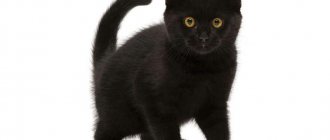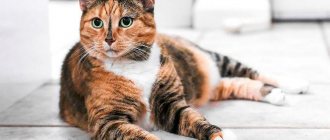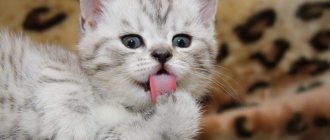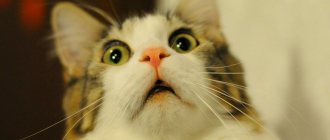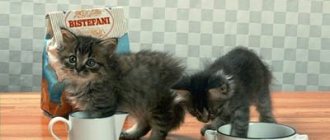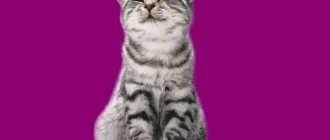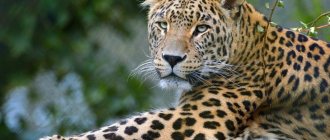Nature has endowed all cats with a difficult character, but black cats are also distinguished by their unusual appearance. People blame these animals for all misfortunes and superstitiously try not to cross them on the road.
Apparently, this is how the subconscious fear of the dizzying beauty of animals in shiny coal-colored coats is expressed. But this color in different combinations is found in almost all cat breeds.
Genetics of black color
The pigment pheomelanin is responsible for the red color, and eumelanin is responsible for the black color. In cat hair they are presented in the form of granules, the shape, quantity and location of which determine the color shade. Let’s leave the first one (red) aside, and consider the second one in detail.
- In black cat breeds, the B (black) gene is responsible for color. In the genotype of an animal, it can be represented in three alleles (species): dominant B, recessive b and bl.
- In the dominant state, the gene forms almost round (slightly elongated at the poles) eumelanin granules with a dense arrangement in the hairs. This gives a rich black color.
- The recessive allele b of the same gene stretches the pigment granules and moves them away from each other. It turns out to be a chocolate shade.
- The final form of bl is even more expanded eumelanin capsules and a sparse arrangement. On the hair this gives the color of cinnamon (cinnamon), characteristic of many breeds.
All other characteristics do not play a role in the color of interest - a large black cat is necessarily a carrier of the dominant B gene.
This is interesting! In black cats, there is no relationship between coat color and the sex of the animal. Their genes are not connected to the chromosomes that are responsible for dividing into “boys” and “girls.”
Why cats are born completely black
There is a simple answer to the question “why are cats born black?” A special pigment, melanin, is responsible for this color. Animals have cells called melanocytes. Melanin bound to protein is deposited in these cells. Melanin is a product of oxidation of the amino acid tyrosine. There are several types of melanins; eumelanin is responsible for brown and black color.
A special pigment is responsible for the black color of cats
There are cats that are born black, but they have white or gray spots - interspersed with lighter hair. And some cats are born completely black, the nose and paw pads are black, but there are no light spots on the body. Heredity is responsible for this feature. Parents with black coloring give birth to black kittens, and if at least one of the parents is a carrier of the genes responsible for white or red color, then a kitten with spots of a lighter color may appear in the litter.
Characteristic eye color
The genetics of the pupil is less studied than the properties of fur. Researchers suggest the presence of a color gene and some polygenes that are located outside the studied structures and affect the characteristic features of the organism.
Felinologists identify three most common combinations:
- Black cats with green (grn) eyes are a classic color combination.
- The second group is orange, brown and amber-honey (org) eyes.
- The final position is in the copper color range (cpr). Fairytale black cats with red eyes actually come from this category.
When recessive alleles (b, bl) come into play and various shades appear on the cat's coat, the pupil color combinations automatically dilate. But absolutely black cats have only the three listed eye colors.
This is interesting! Black coat color is never ideal. It all depends only on the degree of its saturation, which hides some natural pigmentation flaws.
Bombay cat: black standard breed
Bombays are short-haired black cats, fit, graceful, with shiny golden-copper eyes. Their coat has a glossy satin texture, it is evenly colored along the entire length of the hair and lies tightly to the body. The long tail makes the miniature animal look like a wild predator.
The selection was carried out in the USA, where felinologists pursued two goals. Firstly, this is the desire to consolidate the obligatory black color in hereditary characteristics. Secondly, they wanted to obtain an external resemblance to a panther.
The parent breeds were Burmese and representatives of the American Shorthair cat. It took 4 generations of kittens to breed to achieve a positive result.
Bombays are called the most beautiful black cats. Their color must be uniform from root to tip, and uncolored white patches are considered a serious reason for disqualification.
This is interesting! Bombay kittens are born with small spots and bright blue eyes. As they grow older, the animals change color, get rid of alien light patches on their coats, and the color of their eyes becomes golden.
Breeds with acceptable black coloration
In nature, this color is not unique among cats and is often found in any breeding groups. The dominant B gene is stably present both in native breeds (which were formed under natural conditions) and in various hybrid communities or among outbred animals.
big black cats coexist with equally charcoal-shiny homeless strays, and this picture never surprises anyone.
American Bobtail
A rare breed of tailless cats. Their breeding began in the 60s in Arizona and continues to the present day. Among the parents of the American Bobtail are Siamese, Burmese, and Himalayan cats. A distinctive feature of the breed is the absence of a tail, and the color fades into the background.
More often than others, grey-red kittens with a tabby pattern (stripes and spots) are born. Fluffy black cats with a small overgrown tassel in place of the tail are less common, but it all depends on the parents and genetic predisposition.
The mixture of different breeds in the origin of the American Bobtail suggests the appearance of offspring of the most unusual colors, among which there are both solid black colors and combinations of black and white.
Siberian breed: black cat with green eyes
An indigenous Russian cat, which can be recognized as a national treasure of the country. The history of origin is unknown for certain, like most other breeds. But rich long fur, dense undercoat and adaptability to harsh climates indicate that the animal has perfectly adapted to its natural habitat.
The solid colors of Siberians come in two colors: red and black. But if the red tones are intersected by a tabby pattern (stripes, spots or blurred marble), then the coat of a long-haired black cat looks very impressive. In total there are more than 200 combined color options.
This is interesting! Siberian cats became the founders of the Neva Masquerade subspecies - a long-haired breed with a characteristic point mask in red or black shades.
Oriental cat
Oriental cats are champions among black breeds in terms of gracefulness. They are very graceful and sophisticated, on high slender legs, with an elongated wedge-shaped muzzle on a long neck and slightly slanting green eyes. In this color, the wool is evenly dyed along the entire length, from the root to the end.
Among representatives of this species, smooth-haired black cats are also often found.
Devon Rex
Devon Rexes are presented in two categories:
- Like many new breeds that gained official recognition in the 20th century, all modern Devons are descended from a kitten found in the litter of a mongrel cat. He had very large ears and curled fur, for these qualities the cat received the name Kirli (curly).
- It is a rare case when literally everything is known about the first animal in the group - Kirli was a black cat with eyes the shade of yellow amber.
Devons are very active pets - they love to climb onto the owner's neck and sit on his shoulders.
Like other representatives of the “eared” group, they are often called elves, hinting at “extraterrestrial” genetics. Among the popular black cat breeds, Devon cats are not considered. The population is small and black is not the most common color.
Turkish Angora
For more than a century, Turkey has had a program to preserve this breed as a national treasure. We are talking about a classic Angora cat with long or semi-long white hair and multi-colored eyes - yellow and green.
These animals began to be called Angora due to their very soft hair, by analogy with the well-known downy goat breed.
The spread around the world and the efforts of breeders have not benefited the classic white color. It is gradually giving way to other colors, and it is not surprising when black-brown cats with different-colored eyes and a fluffy long tail appear at exhibitions.
It must be admitted that in the pure black version, the shaggy Turkish Angora looks very impressive and rich.
Norwegian forest
Representatives of the aboriginal breed live in Northern Europe. One of the legends about its appearance connects the harsh, unpretentious Norwegians with the pampered southern Angora breed, which has adapted to living conditions in a cold climate.
The forest cat is large, with a double coat, dense undercoat and winter “decorations”: a mane, bib, whiskers and warm pants on the hind legs.
The portrait is completed by neat erect ears with tassels and thick pubescence on the inside of the auricle.
Norwegians are large animals that mature only at 4-5 years of age. Any color is allowed in the breed except those that indicate an undesirable crossbreed: fawn, cinnamon, chocolate and others. Large all-black cats are rare, but black and white cats with thick undercoat are common.
This is interesting! The indigenous qualities of the Norwegian forest cat are protected by an international association. Their out-of-breed crossings are allowed only with a separate permission from WCF.
American Curl
There are representatives of this breed with semi-long and short hair. A distinctive feature of Curls are their ears - wide at the base, semicircular at the top, with reverse folded ears at an angle of at least 90°.
There are no separate requirements for coat and eye color, with the exception of color-point colors with a characteristic blue eye color. In other colors, shades from brown to light hazel are acceptable.
Representatives of this breed with pure black hair are rare. The most beautiful black cats come from short-haired parents. Long-haired pets are traditionally presented in black and white.
Important! The American Curl should not be left alone with small children. Careless caresses can damage the fragile structure of the curled ears.
Manx
The main distinguishing feature of the Manx cat is the absence of a tail. The length of what is left of it cannot extend below the hock joint of the hind legs. But more often there are animals with a 3-7 cm “process”.
When breeding animals, they must select one of the parents with a longer tail - two tailless genes lead to the death of the offspring.
Manx cats are allowed any coat color, except for the color-point varieties. Black kittens are rare, but white or tortoiseshell cats are born consistently.
Cymric
The Cimmerian breed is a semi-longhaired version of the Manx. Breeders united kittens with long hair into a separate group, and then they were recognized by international felinological unions.
Black tailless Cymric cats are born with yellow or green eyes and the typical short "broom" for a tail. They easily adapt to the family and get along well with children and pets.
Coal Bengal
To call this cat black is wrong, but to describe it in any other way is stupid. Bengals are an interspecies mix. Their ancestors are domestic cats and wild Bengal cats. The hybrid received an incredibly beautiful spotted color - contrasting black spots on a golden background.
In appearance, they resemble small leopards with a cute face and an independent character.
The Charcoal Bengal's main coat color is bleached black, and the spots and stripes are less pronounced. Another feature of the animal’s appearance is the mask on its face. Its lines are wider than those of standard-colored cats.
Charcoal Bengal charcoals do not have any privileges in the standard and are subject to general expert rules.
Chausie
Another hybrid of a domestic cat (this time an Abyssinian) and a wild jungle cat. The desire to breed a harmless animal with the external signs of a predatory animal does not leave breeders, and they are finding more and more sophisticated ways. Chausie (housey) is another experiment in this chain.
This breed has only three colors:
- silver;
- tabby;
- black.
It is not recommended to keep Chausies in an apartment, as they need space to play and move.
Black and white color standards
There are three types of black and white color, fixed in the relevant standards.
Table: classification of black and white colors
| Color type | Black and white color code | Main characteristics of color | Type of distribution of white color in a cat's color according to FIFE standards | External differences |
| Wang | n01 |
| The color of Van cats suggests that it contains 5/6 white |
|
| Harlequin | n02 |
| The color of a harlequin cat suggests that it contains from 1/2 to 5/6 white; it is an intermediate type of white distribution between van and bicolor |
|
| Bicolor | n03 |
| The color of bicolor cats suggests that it contains from 1/3 to 1/2 white. In this case, the bicolor color must be separated from the “with white spots” color, which requires only a slight inclusion of white |
|
Sometimes individual white spots on a cat's black coat appear without the participation of the dominant S gene. Their manifestation is due to the influence of both the most recessive form of the white piebald gene and a completely independent gene.
Markings appear in the form of white "medallions", "buttons" or spots in the groin. Such spots are acceptable for native breeds, but for selective breeds they are considered a reason for disqualification.
Gallery: types of black and white colors
Van cats have an almost white coat, two colored spots on the head and a completely colored tail.
In a harlequin-colored cat, colored spots occupy approximately a quarter of the body and can form any fancy patterns. When the dark color begins to dominate over the white, the color is called bicolor
Other breeds of black cats
Cats with black fur are found in almost all aboriginal groups. The Maine Coon is a very interesting breed - a champion in height, length and weight. It is in this breed that huge black cats in solid color or with white accents are often found.
Unlike the newly bred mestizos, all natives are good-natured, loyal to people and endowed with good health. The only difficulty is breeding. International expert organizations require compliance with the rules for crossing with other breeds.
Solid colored cats
Cats of solid (or solid) colors - white, black, red and blue - are characterized by copper or orange eyes.
Canadian Sphynx Cream British cat Exotic shorthair, black color
But in animals of solid chocolate, lilac colors and, more rarely, fawn and cinnamon, eyes of lemon, golden and amber shades are quite often found.
Burmese cats are characterized by bright, expressive golden eyes.
Grooming
Hair care for cats depends on the breed and physical condition of the animal.
- Long-haired and semi-long-haired pets need regular brushing. The procedure must be repeated daily, and during molting - several times a day.
- When caring for a black cat with short hair, special combs and brushes are used that collect small hairs.
Important! The “fur coat” of any cat is an indicator of its health. If the fur loses its shine or falls out excessively, you need to reconsider the animal’s diet and show your pet to a veterinarian.
